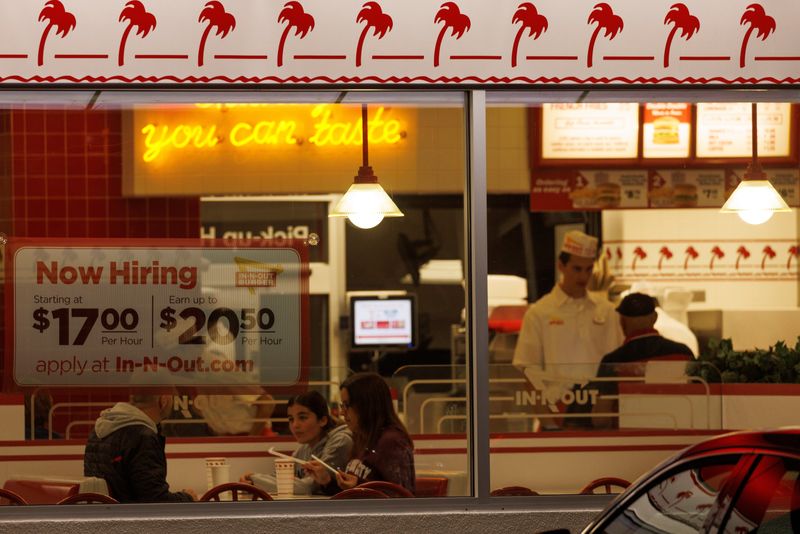By Lucia Mutikani
WASHINGTON – The number of Americans filing new claims for unemployment benefits fell less than expected last week, suggesting some cooling in the labor market, though conditions remain tight.
There are growing signs the Federal Reserve’s aggressive efforts to slow demand and bring down inflation to its 2% target are starting to have an impact. Homebuilding slumped to a 13-month low in May, while a gauge of factory activity in the mid-Atlantic region contracted for the first time in two years in June.
The U.S. central bank on Wednesday raised its policy interest rate by three-quarters of a percentage point, the biggest hike since 1994.
“The Fed is getting what it wants as financial market conditions tighten and interest rate-sensitive parts of the economy respond to the removal of monetary policy accommodation,” said Ryan Sweet, a senior economist at Moody’s Analytics in West Chester Pennsylvania.
Initial claims for state unemployment benefits slipped 3,000 to a seasonally adjusted 229,000 for the week ended June 11, the Labor Department said. Economists polled by Reuters had forecast 215,000 applications for the latest week.
The decline left the bulk of the prior week’s jump intact, which had lifted filings close to a five-month high. California reported a surge in unadjusted claims last week. There were notable rises in Ohio and Michigan, potentially related to the auto industry. Claims also increased considerably in Illinois and Pennsylvania, but fell in Missouri.
There has been a steady rise in reports of job cuts, mostly in the technology and housing sectors. Still, claims have remained locked in a tight range since plunging to more than a 53-year low of 166,000 in March.
Fed Chair Jerome Powell told reporters on Wednesday that “the labor market has remained extremely tight,” and that “labor demand is very strong.” The U.S. central bank has increased its benchmark overnight interest rate by 150 basis points since March.
There were 11.4 million job openings at the end of April. The number of people receiving benefits after an initial week of aid rose 3,000 to 1.312 million during the week ending June 4.
“For now, supply and demand mismatches will keep filings low,” said Rubeela Farooqi, chief U.S. economist at High Frequency Economics in White Plains, New York. “But the level could start to trend up as the Fed continues to remove policy accommodation to slow demand.”
Thursday’s data followed on the heels of news this week of a surprise decline in U.S. retail sales in May, amplifying fears of a recession.
Stocks on Wall Street tumbled. [.N] The dollar fell against a basket of currencies. [FRX/] U.S. Treasury yields fell. [US/]
LOSING SPEED
The housing market, the sector most sensitive to interest rates, is losing speed. But this could help to bring housing supply and demand back into alignment and lower prices.
A separate report from the Commerce Department showed housing starts plunged 14.4% to a seasonally adjusted annual rate of 1.549 million units last month, the lowest level since April 2021. Economists had forecast starts would slide to a rate of 1.701 million units.
Permits for future homebuilding declined 7.0% to a rate of 1.695 million units. A survey on Wednesday showed the National Association of Home Builders/Wells Fargo Housing Market sentiment index hit a two-year low in June, with a gauge of prospective buyer traffic falling below the break-even level of 50 for the first time since June 2020.
Single-family housing starts, which account for the biggest share of homebuilding, tumbled 9.2% to a rate of 1.051 million units last month, the lowest since August 2020. Starts rose in the Northeast, but fell in the Midwest, South and West regions.
The 30-year fixed-rate mortgage jumped 55 basis points this week to a 13-1/2-year high of 5.78%, mortgage finance agency Freddie Mac reported on Thursday. That was the largest one-week increase since 1987.
“Rising rates aren’t all bad news, however,” said Jacob Channel, senior economist at LendingTree. “Though it’s unlikely that home prices will majorly slump, an increase in housing supply will likely significantly slow home price growth and give would-be buyers more housing options to chose from.”
Building permits for single-family homes declined 5.5% to a rate of 1.048 million units, the lowest since July 2020.
Starts for housing projects with five units or more dove 26.8% to a rate 469,000 units. Multi-family housing permits dropped 10.0% to a rate of 592,000 units.
The number of houses approved for construction that are yet to be started increased 0.7% to 283,000 units. Housing completions were the highest since 2007, which together with slowing demand could help to lower prices.
Goldman Sachs trimmed its second-quarter gross domestic product estimate by two-tenths of a percentage point to a 2.8% annualized rate. The economy contracted at a 1.5% pace in the January-March quarter.
“The Fed’s aggressive and abrupt policy tightening may soon be criticized for letting in the winds of recession,” said Christopher Rupkey, chief economist at FWDBONDS in New York.
(Reporting by Lucia Mutikani; Editing by Nick Zieminski and Paul Simao)
